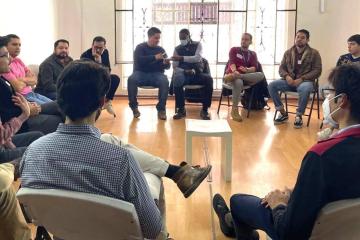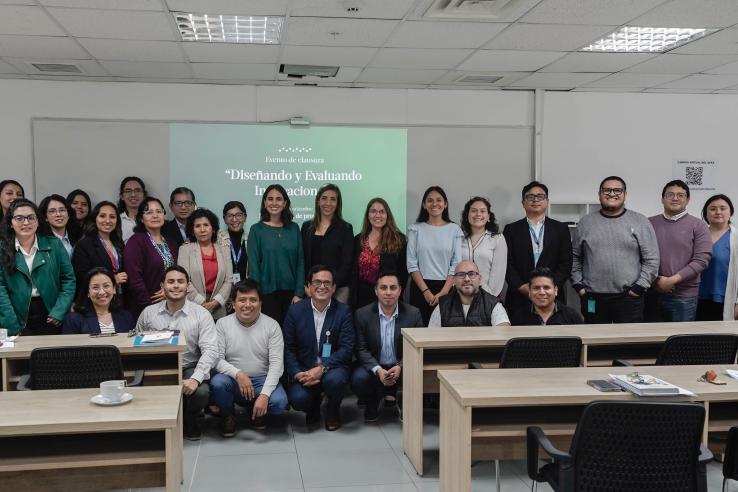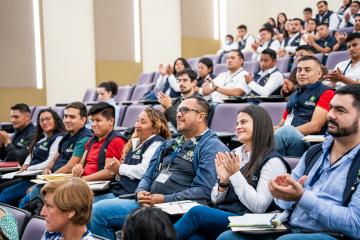
J-PAL LAC government partnerships: Pathways to evidence

Our work at J-PAL Latin America and the Caribbean (LAC) is made possible by close collaboration with and the dedication of many regional governments who recognize the importance of using data and evidence to improve social programs and public policy. Over the past fifteen years, we have worked with more than twenty government agencies across the region. This is the third blog post in a blog series titled "J-PAL LAC Government Partnerships," in which we are sharing key insights from this invaluable work. Our first post spotlighted lessons on reducing gender-based violence and the second one highlights lessons on supporting government decision-making in Guatemala.
At J-PAL, we are dedicated to strengthening social interventions and reducing poverty by using scientific evidence to shed light on the most effective ways to unlock the full potential of millions of people worldwide. Yet, building a culture of evidence-informed decision-making is a complex journey—one that demands technical capabilities and a supportive institutional environment. In Latin America and the Caribbean (LAC), government-led social programs hold the highest potential to drive meaningful change. The J-PAL LAC office partners with governments across the region, working to expand the use of rigorous evidence in shaping public policy. Along the way, we’ve gathered valuable lessons that we’re eager to share with you.
Lesson 1: Focus on the problem, not the solution you're in love with
Incorporating evidence into decision-making requires overcoming obstacles such as limited time, uncertainty, or the tendency to rely on familiar approaches. Yet despite these challenges, the first step toward a meaningful relationship between evidence and policy is understanding that every solution should start with a clear grasp of the problem.
Defining the problem is a challenge in itself. It demands a thoughtful diagnosis that identifies its causes, its scale, and who is affected. A precise problem definition is essential—not only for designing and rigorously evaluating new interventions, but also for identifying and adopting proven solutions supported by strong evidence.
There are plenty of cases where this principle wasn’t followed. For instance, despite growing evidence showing no significant impact on learning outcomes from distributing laptops in primary schools, many governments continued to do so, hoping it would enhance educational results. Centering the problem means rethinking solutions and being open to generating new evidence about what truly works.
Falling in love with a solution before understanding the problem limits the effectiveness of interventions and weakens institutions’ ability to learn and improve. In complex contexts, revisiting and reframing the problem can be a powerful way to reconnect solutions with real needs—and to move toward more coherent, sustainable public decisions.
Take the case of laptops. Before purchasing even one, it’s crucial to ask: What exactly is the problem, and what’s causing it? Are students struggling because they can’t follow the lessons? Or is the real issue that they don’t even attend school? Only by identifying the root cause can we assess whether an electronic device might be part of the solution. A computer won’t fix absenteeism. But if the core issue is a shortage of teachers, laptops might support autonomous learning and help bridge that gap.
Lesson 2: There are multiple pathways to catalyze the use of evidence in public policymaking
Even when governments have a strong starting point, there is no single path to institutionalizing the use of evidence. Some processes begin by building technical capacities or designing tools, while others start by incorporating existing evidence or preparing interventions for evaluation. Recognizing this diversity allows us to support each institution based on its real-world context, tailoring the type of collaboration and pace of progress accordingly.
One possible pathway is institutional strengthening. After identifying technical capacities, internal processes, and enabling conditions, it becomes possible to design a strategy that leverages existing elements as a foundation for expanding and deepening institutional capabilities. A notable example is the collaboration launched in 2023 in Mexico between J-PAL LAC and the Secretariat for Planning and Citizen Participation of the State of Querétaro (SPPC). This partnership has focused on designing new policies, modifying existing interventions, and evaluating their impact. As part of this effort, J-PAL LAC has supported capacity-building within the Secretariat, which plays a leading role in promoting evidence-based use and works closely with other government units to achieve its goals.
In this collaboration, SPPC identified two key needs: integrating causal thinking through theories of change and incorporating rigorous evidence into day-to-day policymaking. This gave rise to the Instrument for the Evaluation of Public Policies (EVAPOP), a management tool designed to inform the design, evaluation, or redesign of government programs. Its use has promoted structured technical discussions and laid the groundwork for future impact evaluations.
The SPPC case exemplifies how the combination of practical tools, technical support, and institutional commitment can foster a more reflective and evidence-informed approach to public management. This experience enabled the expansion of the partnership to the municipality of Santiago de Querétaro and the advancement of IMPACTA, a web application with embedded audiovisual resources and access to evaluation repositories, inspired by EVAPOP. IMPACTA is designed to foster future partnerships across the region as an initial step towards evidence use. These efforts demonstrate the potential of shared learning to unlock new possibilities for the strategic use of evidence.
Another path lies in establishing units dedicated to innovation and evaluation. Policy labs are co-creation spaces where government officials and academic partners develop high-impact, evidence-based solutions. These labs fulfill their purpose by identifying relevant policy questions, designing potential solutions grounded in evidence, and evaluating their effectiveness.
Creating these labs requires establishing innovation-oriented structures and processes, along with the institutional capacities to sustain them. For example, drawing on prior experience, J-PAL LAC and Innovations for Poverty Action (IPA) are supporting the Environmental Oversight and Evaluation Agency (OEFA) in Peru to implement a lab focused on environmental regulation and enforcement. This work has involved both administrative tasks, such as creating the lab’s organizational structure and defining its processes, and capacity-building activities, including training on evaluation and innovation incubation, using a hands-on, learning-by-doing approach. The ultimate goal is for OEFA to develop and evaluate its own innovations independently.
Lesson 3: Keep moving forward... and don't lose sight of the goal!
There may not be a single model to follow. Still, our partnerships are grounded in a shared conviction: that focusing on solving the problem is the first step toward using—and building—rigorous evidence to guide public policy. Tracing the path forward depends on the specific needs, strengths, and opportunities available to each organization.
Building and sustaining this organizational culture relies on continuous improvement and the exchange of experiences and lessons learned with others. Over the years, we’ve learned that moving toward a culture of evidence doesn’t mean replicating what’s already been done—it means creating shared spaces to rethink problems, experiment with solutions, and document what truly works.
If achieving a culture of evidence use in policymaking takes real and sustained effort, why go through the trouble? Because in this collective race, the finish line holds great promise: co-creating interventions that can transform the lives of millions across the region.



